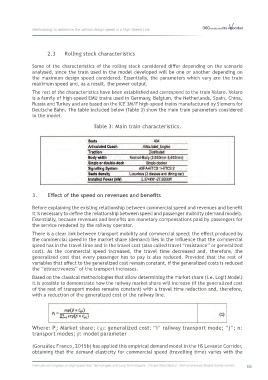Page 537 - 360.revista de Alta Velocidad - Nº 6
P. 537
Methodology to determine the optimal design speed in a High-Speed Line
2.3 Rolling stock characteristics
Some of the characteristics of the rolling stock considered differ depending on the scenario
analysed, since the train used in the model developed will be one or another depending on
the maximum design speed considered. Essentially, the parameters which vary are the train
maximum speed and, as a result, the power output.
The rest of the characteristics have been established and correspond to the train Velaro. Velaro
is a family of high-speed EMU trains used in Germany, Belgium, the Netherlands, Spain, China,
Russia and Turkey and are based on the ICE 3M/F high-speed trains manufactured by Siemens for
Deutsche Bahn. The table included below (Table 3) show the main train parameters considered
in the model.
Table 3: Main train characteristics.
3. Effect of the speed on revenues and benefits
Before explaining the existing relationship between commercial speed and revenues and benefit
it is necessary to define the relationship between speed and passenger mobility (demand model).
Essentially, because revenues and benefits are monetary compensations paid by passengers for
the service rendered by the railway operator.
There is a clear link between transport mobility and commercial speed; the effect produced by
the commercial speed in the market share (demand) lies in the influence that the commercial
speed has in the travel time and in the travel cost (also called travel “resistance” or generalized
cost). As the commercial speed increased, the travel time decreased and, therefore, the
generalized cost that every passenger has to pay is also reduced. Provided that the rest of
variables that affect to the generalized cost remain constant, if the generalized costs is reduced
the “attractiveness” of the transport increases.
Based on the classical methodologies that allow determining the market share (i.e. Logit Model)
it is possible to demonstrate how the railway market share will increase (if the generalized cost
of the rest of transport modes remains constant) with a travel time reduction and, therefore,
with a reduction of the generalized cost of the railway line.
Where: P : Market share; : generalized cost; “i” railway transport mode; “j”; n:
i
transport modes; : model parameter
(González Franco, 2015b) has applied this empirical demand model in the HS Levante Corridor,
obtaining that the demand elasticity for commercial speed (travelling time) varies with the
International Congress on High-speed Rail: Technologies and Long Term Impacts - Ciudad Real (Spain) - 25th anniversary Madrid-Sevilla corridor 535

